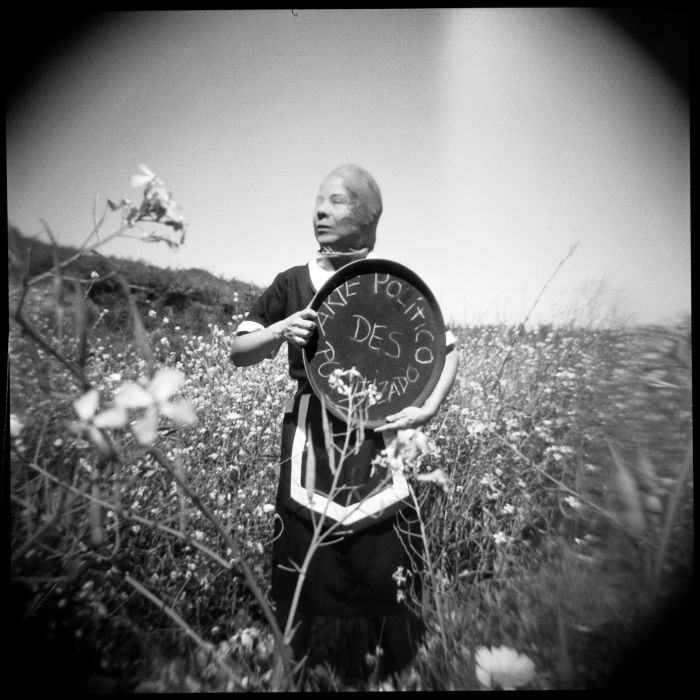Terminé le 17.01.21

Présenté dans laGalerie du Soir
Sarah Joveneau. Piel de lucha
“I embarked on writing at a very early age,” Sarah Joveneau, author of the Piel de Lucha series, tells us. “I used to write a lot when I was a kid. Our sixth-form French teacher ask us to keep a sort of cultural diary. That was the context for my coming to the Museum of Photography and it was there I discovered Roger Job’s work on the Turkana. I was deeply moved. I had already travelled a great deal with my dad. My father is a field reporter who likes to go out and meet people, but the discovery of Roger Job’s work was a eureka moment. I was overwhelmed by his long-haul approach. I therefore handed in an entire text on this subject to my French teacher and then, when the time came to make a decision regarding the future focus of my studies, I went to the open day at Saint-Luc Arts School. I kind of liked it and I took the plunge.”
Listening to Sarah Joveneau, everything on her learning pathway more or less follows naturally. And yet there is nothing obvious or tranquil in her work. For several years now, as a photographer, a video maker (she also trained in cinematography after photography) and, perhaps more basically, as a human being, she has been travelling the world, going out to meet the most diverse range of people and endeavouring to report on the struggles of some and the life choices of others ... “Moving?” It has always been a way a life and one she enjoys. “Already during my studies at Saint Luc, I embarked on a long report on the road with travellers who lived in a lorry and moved around everywhere. Most of the time, I travelled by hitch-hiking because I didn’t have a lot of money.” Sarah Joveneau’s declarations are moreover taken from a discussion that took place on a Saturday morning when the young photographer was travelling to Occitania for a writing residence. When she phoned us, she had just arrived on the edge of a road and was getting ready to thumb a lift. “Nowadays, I am not necessarily at home,” she explains. “I am often on the road with my rucksack.” The road is the road she chooses depending on her projects, on her areas of interest, on pieces of information that she picks up here and there from things that attract her attention. And sometimes, hitch-hiking is not enough to reach these destinations. Especially when it came to travelling to Chile. “I went to Chile for the shooting of a film in which I was involved but I didn’t see myself making a round trip and only staying in Chile for five days. When I heard that there was a signi- ficant mobilisation of women in that country, I arranged with the production team to reschedule my return flight. I left the team at the airport and I started my project which lasted just under two months locally.”
A project that was going to turn out quite differently from what Sarah had planned. “A few days before my departure for Chile, my digital equipment was stolen from my car. Now, I had planned to make a filmed documentary about that struggle by Chilean women, while using the digital camera. All of a sudden, I had to settle for analogue equipment and, of course, drop the idea of making video footage and turn to the photo instead.”
With the result that the young woman took square, black and white pictures; something she had never ever done before. And a work focusing on the very unusual struggle of those Chilean women. “I always inquire about the country to which I am going. I look for places where I am going to be welcome as a traveller: citizen movements, squats ... I had been interested in these women’s movements for some time but when I saw all that was involved, I realised that our views on fe- minism are locked in a Eurocentric approach whereas vastly different views exist elsewhere. In Chile, women demonstrate with their bodies, by gathering to sing and dance. Because it is not just about freedom from man’s power today. For those women whom I followed, it is a way of freeing themselves from the colonisation of the body, which deprived them of a multitude of things. Before the arrival of Europeans, women, but also homosexuals and cross-dressers, considered as magical beings, acted as shamans, and had an essential role in the community. The arrival of Europeans and Christianity disrupted all that, creating a binary vision of society and giving all the power to men.” Following a score or so of those women who want both to rid themselves of the power of men and bring magic back to society, Sarah Joveneau photographed those bodies, those skins, entering into a dialogue of co-creation with each of them. For the purpose of making their voices heard far beyond the borders of their country.

